Recall Archive
Ryobi Recall: Fan Blade Pieces Can Break Off
March 15th, 2017. By LucyC
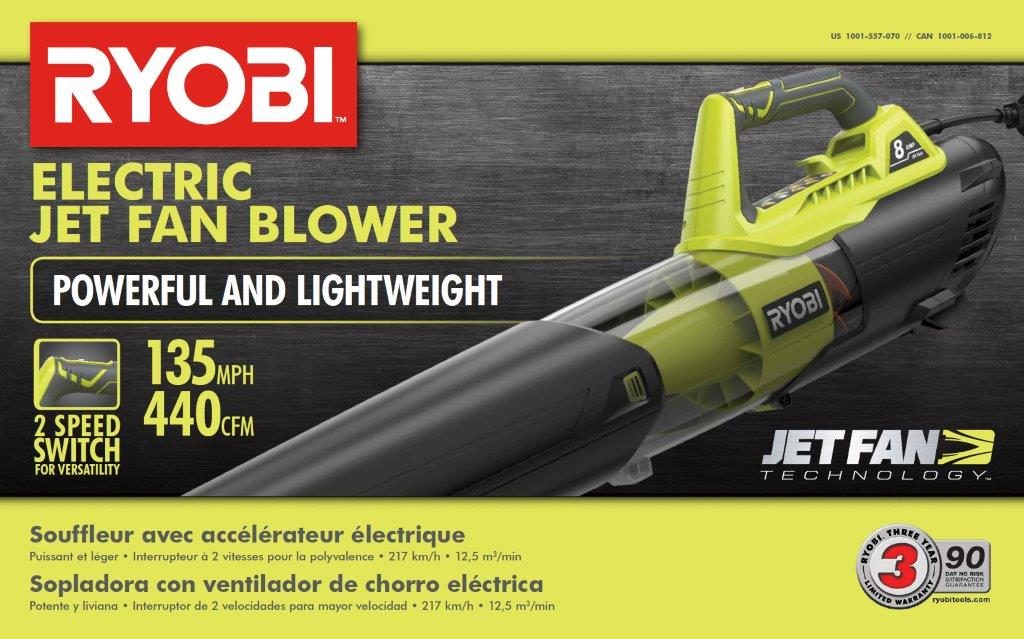 A jet fan blower that bites? You betcha! Ryobi is recalling its defective electric jet fan blowers—not really sure what these are—but I’m guessing it might have something to do with gardening.
A jet fan blower that bites? You betcha! Ryobi is recalling its defective electric jet fan blowers—not really sure what these are—but I’m guessing it might have something to do with gardening.
The recall has been prompted by a rather high number of reported injuries. Apparently, the blower is prone to breaking in a rather bad tempered sort of way, having already caused 10,681 “incidents”, including 25 reports of minor injuries, such as lacerations to the face, hands and legs. These injuries are caused by fan blade pieces being discharged from either end of the blower. Got that?—EITHER end.
The deal is, according to the Consumer Products Safety Commission (CPSC), the plastic fan inside the blower can break “causing the fan blades to be discharged from either end of the blower tube, posing a laceration hazard.” Read the rest of this entry »
Two Recalls: Portable A/C Unit and Qbit Baby Stroller
December 20th, 2016. By LucyC
Two important recall notices to share this week…
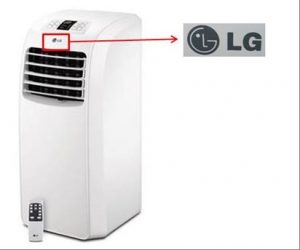
Image: CPSC.gov
LG Air Conditioner. This one goes out to all you lucky people who live somewhere on the continent where it doesn’t snow—or maybe such a place doesn’t exist anymore.
In any event, nearly half a million LG portable air conditioners are being recalled – just in time for Christmas – of course! Why, you ask? Funny thing, they can catch fire and cause property damage, burn down your house, maybe your neighbor’s, if the fire department doesn’t arrive in time, and possibly worse. You get the picture.
I would say that’s a defect in the design, particularly given the idea is to cool down the surrounding environment – not cause a fire that could be seen from space.
Apparently, LG has received four reports of fires that have caused a whopping $380,000 in property damage. Thankfully, no injuries have been reported. Read the rest of this entry »
8M Cuisinart Food Processors Recalled, 1996-2015 models
December 13th, 2016. By LucyC
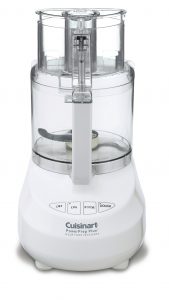
(Image: CPSC.gov)
Wouldn’t want to be in shipping and receiving for this recall. Cuisinart is recalling “about 8 million” food processors, and a further 300,000 in Canada, because it can slice and dice your tongue and teeth in addition to the fruit and veg.
It seems that the food processor’s riveted blade can crack over time and small, metal pieces of the blade can break off into the processed food. As the Consumer Protection Safety Agency so eloquently puts it, “This poses a laceration hazard to consumers.”
Not a great deal more you need to add to that, really. After all, there’s not much grey area in chewing blades and cutting you mouth. As some 30 people who have reported cutting their mouths and injuring their teeth can no doubt attest to. Imagine asking your guests, “How’s the Hummus?” Yeah, ok—let’s not go there.
Apparently, Conair has received 69 reports of consumers finding broken pieces of the blade in processed food, including those 30 reports of mouth lacerations or tooth injuries. And of course, those terrible horror movies from the seventies come to mind, for those of you old enough to remember. Think Texas Chain Saw Massacre and its ilk, for example. It’s the foodie version… (Although chasing someone around the house with a food processor doesn’t quite have the same impact as a chain saw. I digress.)
In case you’re wondering, as most people would, if you own one of these defective food processors, the relevant information is thus:
“This recall involves the riveted blades in Cuisinart food processors with model numbers that begin with the following: CFP-9, CFP-11, DFP-7, DFP-11, DFP-14, DLC-5, DLC-7, DLC-8, DLC-10, DLC-XP, DLC-2007, DLC-2009, DLC-2011, DLC-2014, DLC-3011, DLC-3014, EV-7, EV-10, EV-11, EV-14, KFP-7 and MP-14. The model number is located on the bottom of the food processor. The blades have four rivets and are silver-colored stainless steel and have a beige plastic center hub. Only food processors with four rivets in the blades are included in this recall. Cuisinart is printed on the front and on the bottom of the food processors.” (CPSC.gov/recalls)
You can contact Cuisinart toll-free at 877-339-2534 from 7 a.m. to 11 p.m. ET Monday through Friday and from 9 a.m. to 5 p.m. ET Saturday and Sunday or online at www.cuisinart.com and click on Product Recalls at the bottom of the page for more information. Apparently, Cuisinart is offering replacement blades. Think I would give that some serious consideration.
The food processors were sold at department, gourmet and specialty stores nationwide and on various websites from July 1996 through December 2015 for between $100 and $350. They were distributed by Conair Corp., of Stamford, CT, owner of the Cuisinart brand, and made in China.
Think I’ll ask Santa for a good set of kitchen knives.
67,000 Panic Devices Recalled for Failure to Work
October 12th, 2016. By LucyC
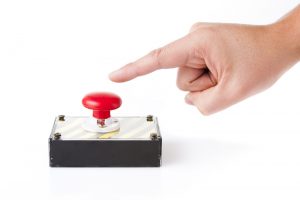 Interesting recall recently—a wireless personal panic device that fails to panic when you need it to. In fact, according to the Consumer Products Safety Commission report, the device can fail to operate altogether in times of crisis, so it “fails” to send a signal to the security system to which it is presumably linked, in case of an emergency. That certainly sounds helpful.
Interesting recall recently—a wireless personal panic device that fails to panic when you need it to. In fact, according to the Consumer Products Safety Commission report, the device can fail to operate altogether in times of crisis, so it “fails” to send a signal to the security system to which it is presumably linked, in case of an emergency. That certainly sounds helpful.
The description is very polite and clearly not meant to cause panic “The wireless personal panic devices can fail to operate, which could result in the device not communicating with the security system if activated in the event of an emergency.” You practically have to read this sentence twice to get the drift. Not alarming at all. (pardon the pun).
So what’s the deal? Does it freeze with fear? Major crises are not in its contract? Who knows. Suffice to say it’s all quite worrying, really. In fact, it could be enough to send you clean over the edge if you’re having or about to have a crisis. It’s also enough to send anyone who purchased one of these for an elderly relative into a state of serious concern. Not good. There you are—or your loved one—in the dark, alone, no way to get to a phone, or contact a passerby or neighbor and the device you purchased in good faith to support you this time of crisis goes: “ah, NO, sorry—not my job.” You can imagine, knowing how completely absorbing all this wearable technology is, that should this thing fail when you need it, you could become more obsessed by trying to get it to work than by the actual event that should have triggered its response.
Never mind the burglar, the chest pain, the mudslide, the 10 car pile-up on your front lawn, the creek that’s turned to class five rapids in your back yard—whatever it may be—the wrist-mounted Interlink device is giving the silent treatment or some kind of error message. And you’re wondering, “did I charge it properly—did I charge it at all? What if I turn it off then on again, or shake it? Oh, but now it won’t turn off, why is it so slow…no wait—there it goes. OMG—why is it so slow?”
Then your thought process is interrupted by the other reality. The emergency. Oh yeah, forgot about that. But maybe distraction is helpful? In any event, there you are in the dark, cold, silence. Just you, and your worthless, wireless personal panic device and the crisis, which presumably is now in full unfold mode. And you didn’t notice.
What are you going to do? Summon the Force? Wait and see if anyone comes? Hope someone else called 911?
Don’t panic—at least there’s the recall, and the fix. If you own one of these Interlogix® wireless personal panic devices, and apparently 67,000 of these devices have been sold across the U.S., the recommendation is that “Consumers should immediately contact their professional security system installer or monitoring company for a free inspection of their personal panic device and a free replacement device for those that fail inspection.” Probably best not to do this immediately—you might want to finish the crisis at hand before embarking on a new one with customer service.
Consumers should contact: Interlogix® at 800-394-4988 Monday through Friday, from 8 a.m. to 8 p.m. PT, email at , or online at www.interlogix.com and click on Customer Service for more information. These devices were sold, through professional security installers and distributors nationwide from May 2014 through January 2016 for about $35 to $50.
Mind the Gap? Elevator Lock Recall Worth Minding
August 16th, 2016. By LucyC
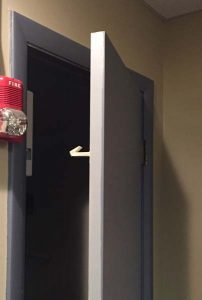
Photo: CPSC.gov
Going Down?
No…wanted to go up actually. But who pays attention to those details, up, down, whatever—I usually get in for the ride before I realize the direction I’m going in—not a great metaphor for life but I digress.
To get to the point (good luck with that), there’s been an elevator recall. Don’t panic if you’re reading this on your way up to your office on the 35th floor. The recall involves residential elevators fitted with electro mechanical door locks. I believe the lingo is EMDLs. Guess what—they don’t work. The locks, not the elevators.
Apparently, the plastic locks can “allow” the landing door to open before the elevator car arrives, “posing a serious fall hazard to consumers attempting to board the elevator.” Allow? So locks can think now? What are the criteria upon which the locks make the decision to open—they don’t like the way you’re dressed? You or your progeny punched all the buttons on your last ride? Enquiring minds want to know.
Back to the recall, I believe the CPSC is attempting to warn people like myself who just move forward when the doors open, not paying attention to direction—as previously stated, or whether or not the elevator is even there. Details, right?
So to put this in context, you’ve pressed the button and now you’re back to your Pokemon Go thing when the outer door to the elevator opens. You are, quite reasonably, assuming that you’re going up to the 2nd floor, when in fact you are going to be taking a quick and potentially catastrophic slip and fall kind of move—without the elevator. All thanks to the EMDLs. (Wanted to use that).
The CPSC is advising, as a remedy, that “Consumers should immediately stop using elevators equipped with the electro mechanical door locks and contact their elevator service company to have the plastic locks replaced with metal parts.” Good advice. For those of us who read these things. I can’t help but wonder how they found out the locks weren’t working properly in the first place?
So far, Porta, the EMDLs manufacturer, has received two reports of lock failure. No injuries have been reported—remarkably. Or perhaps the bodies haven’t been discovered yet? Granny’s missing…but who would think to check the elevator shaft? On reflection, this does sort of have the makings of a Stephen King horror film. Remember “The Shining”?
And for your information, this is no minor recall—there’s 60,000 defective (or empowered, depending on how you want to interpret it) EMDLs out there.
Here’s the CPSC information: “This recall involves all residential elevators with plastic electro mechanical door locks. The EMDLs are installed as part of a complete residential elevator system. Locks included in this recall have a plastic generation 1, 2, 3 or 4 latch and keeper attached to the upper corner on the elevator side of each landing door. A UL or ETL label affixed to the bottom of the EMDL box has “Porta Inc.” printed on it.”
In case you have one of these EMDLs installed, the CPSC advises that “Consumers should contact their elevator service company. Consumers can also contact Porta Inc, toll-free at 844-719-9037 from 8 a.m. to 1 p.m. CT Monday through Thursday or online at www.emiporta.com and click on “Important Product Safety Notice” for more information. Consumers also can email the firm at .
They were sold through elevator manufacturers nationwide from January 2005 through December 2011 for between $20,000 and $40,000. Wow. Wonder what the fix is going to cost…
Better start paying attention—a good metaphor for life.
Archive by Category
- Accidents (24)
- Airlines (9)
- Asbestos Mesothelioma (262)
- Automotive (25)
- Celebrity (14)
- Class Action (84)
- Complaints/Comments (15)
- Consumer Fraud (84)
- Contest (2)
- Court of Public Opinion (5)
- Crazy Sh*t Lawyers See (61)
- Criminal Law (4)
- Defective Products (111)
- DePuy ASR Hip Recall (2)
- Discrimination (22)
- Drugs/Medical (248)
- Elder Care Abuse (4)
- Emerging Issues (462)
- Employment (54)
- Environment (52)
- Financial (28)
- Food Illness (15)
- Human/Civil Rights (4)
- Insecurities (5)
- Insurance (16)
- Intellectual Property (16)
- Internet/E-commerce (19)
- lawsuits (161)
- Lawyers (20)
- Lawyers Giving Back (43)
- Lex Levity (10)
- Personal Injury (106)
- Pleading Ignorance (53)
- Real Estate (2)
- Recall (6)
- Scam (3)
- Securities (13)
- Settlement (81)
- Tort Reform (2)
- Totally Tortelicious (81)
- Veterans (11)
- Whistleblower (9)